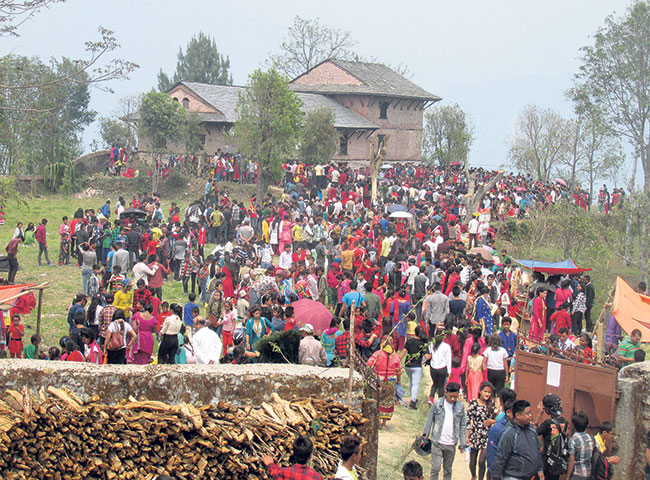The construction of Dalit Museum in Gaunsahar of Thumkidhada is about to finish. With the establishment of the museum, the area is expected to be a visitors’ hub. Gaunsahar also boasts a persuasive home stay facility, initiated by the District Development Committee, for its guests.
The museum is being developed with an aim to let the tourist gain knowledge about the historical background, culture, society and lifestyle of the Dalit people living in the area. Construction of the museum was started with the initiation of local Janajyoti Youth Club along with Rakestha Ama Samuha and Jayshree Ganesh Baba Samusha some four years ago.
The museum is being built with the use of stone, mud and wood in such a way so as to reflect the authenticity of the place. To add originality and a traditional touch, the museum also has aakhijhyal (traditional wooden windows), traditional wooden folding doors, and carved wood ladders known as ‘lisnow’.
Harkabahadur Maurti, a carpenter involved in the museum’s construction, said the structure was being developed in such so as to depict the traditional houses of Gaunsahar area. He added, “Though we’ve also used cement for durability, various elements have been incorporated in the design to give it a local feel.”
Museum hotel to reflect Nepal’s cultural, ethnic diversity

The museum
will house authentic and traditional tools along with goods made from those tools such as dhiki, jaanto, silauta, theki, madani and aaran.
According to Advisor of Janajyoti Youth Club, Ajaya Majakoti, as much as one million rupees has been invested so far for the decoration, foundation and boundary wall of the museum. He added, “The management team of the Dalit Museum received Rs 300,000 from the District Development Committee, while the Dalit Trust and Tourism Program under the Municipality collectively gave away Rs 133,468 for the construction.”
Likewise, as much as Rs 500,000 was collected through various cultural programs organized in the village and donations from different groups. “Though we received enough fund to build the structure, we don’t have the budget to procure the required items to exhibit at the museum. The interiors alone are estimated to cost around one million rupees. We don’t have that much money,” said Majakoti.
The museum will feature tools and equipment used by the Dalit people to make various things out of bamboo, hide and iron, among others, needed in their daily life. About this, President of the Club, Bijaya Dulala, informed, “The museum will house authentic and traditional tools along with goods made from those tools such as dhiki, jaanto, silauta, theki, madani, aaran, iron tools, golden jewelries, leather shoes, daamlo and bags, among others. The museum will also feature traditional Dalit clothes. Moreover, we are also looking forward to create a traditional workshop of shoes used by the Dalit people in yester years.”
According to him, the establishment of the museum has generated enthusiasm among the locals and this might be the first ever museum dedicated to the Dalit community in honor of their hard work and skills.

He added, “This has been possible only with the encouragement and financial help from the locals and the people who are living and working aboard.” The roof of the museum is 13ft round and the slate was brought all the way from Bandipur. The museum also comprises a shed for poultry farming.
Around 400 Dalit families are settled in Gaunsahar, while the home stay facility in the area was declared the best in the country last year.
Explaining the reason to establish the Museum, Basisahar Municipality Chief Gumansingh Aryal said, “The museum is being established under the Gharbas Program with the locals’ initiation. Moreover, we are expecting that discrimination on the basis of caste and class will be abolished from the society with the establishment of the Museum. Likewise, the museum can also work as a tourism attraction for Gaunsahar and Ghale Gaun.”



































